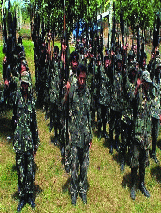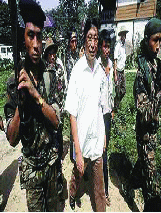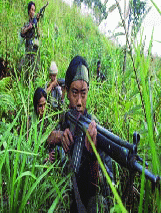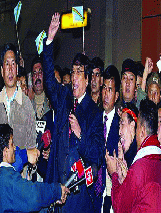Archives
When Peace Comes Knocking
 The relative peace that has been prevailing in Nagaland has been largely contributed to the works of the Forum for Naga Reconciliation (FNR). FNR has been mainly working to bring reconciliation among the warring Naga underground factions. The FNR was born in February, 2008 and it comprises of all the frontal Naga organizations, including the Council of Naga Baptist Churches (CNBC), and with the support of Nagaland Baptist Church Council (NBCC) and the Nagaland Christian Forum (NCF).
The relative peace that has been prevailing in Nagaland has been largely contributed to the works of the Forum for Naga Reconciliation (FNR). FNR has been mainly working to bring reconciliation among the warring Naga underground factions. The FNR was born in February, 2008 and it comprises of all the frontal Naga organizations, including the Council of Naga Baptist Churches (CNBC), and with the support of Nagaland Baptist Church Council (NBCC) and the Nagaland Christian Forum (NCF).
So far, the FNR has had 24 different meetings both within and outside the Naga areas. In all these meetings and gatherings, the Naga political groups, the Naga frontal organizations and the public have made solemn commitments to the process of genuine reconciliation, unity and peace among the Nagas and with confidence.
The leaders of the Naga underground groups have also agreed to constitute a Joint Working Group (JWG) to  further strengthen the reconciliation and resolve to work together in the spirit of love, non-violence, peace, and respect to resolve outstanding issues amongst them.
further strengthen the reconciliation and resolve to work together in the spirit of love, non-violence, peace, and respect to resolve outstanding issues amongst them.
“We are hopeful of a broad based settlement and we are very happy at the initiative taken by the Forum for Naga Reconciliation that helped stop inter-factional killings and violence in the state,” said GK Pillai, Union Home Secretary.
Although the Naga underground groups agreed to halt factional fights and have understanding and reconciliation through the initiative of FNR, the General Secretary of the NSCN (IM), Th Muivah is still skeptical of the views of the Government of India that all Naga groups must unite and come for talks before the final settlement is reached. The NSCN-IM argued that other outfits were non-mandated groups. Muivah had said recently that participation of non-mandated groups in the talks for settlement of the issue would only dilute what has been achieved in the talks so far.
 The Government of India has already submitted its 29-point counter proposal to the NSCN (IM). They are making all out efforts to bring together all underground and tribal groups of Nagaland and hammer out a new political and economic solution acceptable to all. The Center’s proposed package includes financial largesse, greater devolution of powers, special steps for the protection of Naga culture and heritage besides others.
The Government of India has already submitted its 29-point counter proposal to the NSCN (IM). They are making all out efforts to bring together all underground and tribal groups of Nagaland and hammer out a new political and economic solution acceptable to all. The Center’s proposed package includes financial largesse, greater devolution of powers, special steps for the protection of Naga culture and heritage besides others.
Interestingly, the JWG of the Naga underground factions came out against any form of conditional package offered to the Nagas by the Government of India. With the signing of the ‘Covenant of Reconciliation’ and the rejection of “any form of conditional packaged offered to the Nagas by the Government of India,” it was logical that for common interests and actions of the Nagas a united front of sorts was most desirable, they explained. “One of the fundamental truths of the Nagas today is the call for political reconciliation in pursuit of common interest based on the ‘historical and political rights of the Nagas,” they further stated.
They further stressed that any political model of government had to be focused contextually. “Each country has  its uniqueness and as such, what may function politically in one country may not be suitable for another country,” they said. “Therefore, in context, a Naga political model should be envisaged and discussed upon.”
its uniqueness and as such, what may function politically in one country may not be suitable for another country,” they said. “Therefore, in context, a Naga political model should be envisaged and discussed upon.”
The Center-NSCN-IM talks which remained deadlocked will resume in April after nearly a year. The last round of talks between the two was held in March 2009 in Zurich, Switzerland. The Government of India has reportedly sent an official invitation to the collective leadership of the outfit for resumption of talks in the first week of April.
The Government of India may likely press upon the collective leadership during the talks that any final settlement of the vexed Naga political issue will only come about when they are able to sit across the table with the united Naga group. The NSCN-IM leadership may, however, not accept the idea. But the reality is that there will be no final settlement with one group. It may be mentioned that the Government of India has also been maintaining ceasefire with the NSCN (K) since 2001. The outfit is yet to start political talks with the Government of India.
Interestingly, while the NSCN (K) has been sticking to the sovereignty of the Nagas, the NSCN (IM) that was earlier fighting for an independent homeland for the Nagas, has come down to a Greater Nagaland, to be formed by a carving out of the adjoining states that have Naga tribal populations. The demand has, however, been rejected by the Governments of Manipur, Assam and Arunachal Pradesh. It is not that easy to find a solution and it is indeed extremely complex. However, it appears that the Government of India this time may try to find a solution to the long drawn out Naga political issue. This opportunity should not be missed by the Naga people.
Oken Jeet Sandham

